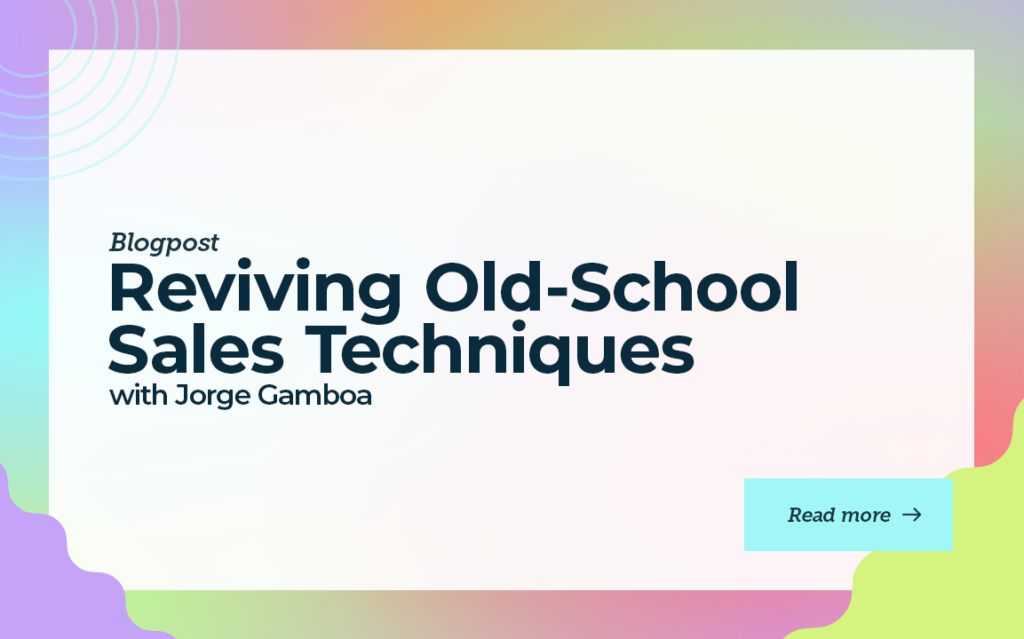Reviving Old-School Sales Techniques with Jorge Gamboa

Outbound sales has evolved dramatically, and the challenges for sales teams have intensified. What worked a decade ago, mass email blasts, standardized cadences, and cheeky breakup emails don’t hold the same weight today.
Prospects have adapted, and the “spray and pray” tactics of yesteryears are no longer effective.
Yet, outbound sales is far from dead. Instead, it demands a refined, back-to-basics approach emphasizing personalization, authenticity, and genuine human connection.
Jorge Gamboa, co-founder of Magellan, joined the Predictable Revenue Podcast to unpack the hurdles of modern outbound selling and how old-school techniques are making a powerful resurgence in this high-tech era.
Why Selling Feels Tougher Today
Selling has always been challenging. That’s why top-performing sales reps are highly compensated. But in today’s saturated market, the barriers are higher than ever. Sales leaders notice that the same sequences and tactics that once generated responses now elicit silence. Why?
- Prospects Are Savvier: Automated sequences and variable-filled templates feel impersonal. Prospects have learned to tune out these messages, equating them to spam.
- Too Much Noise: Every rep seems to be fishing in the same pond with identical bait, making standing out exponentially harder.
As Gamboa puts it, the essence of sales hasn’t changed. It’s still about psychology and human connection. However, what’s shifted is the necessity to rise above the noise, not with mass outreach but with thoughtful, tailored engagement.
Finding the Sweet Spot Between Scale and Personalization
While automation has revolutionized outbound sales, the over-reliance on templates has stifled creativity. What’s missing today is the ability to balance scale with relevance. Gamboa shares how incorporating fallback emails, A/B testing, and even quirky messaging, like a simple “Hail to the Chief” for Chiefs of Staff, helps inject personality into sequences.
However, crafting these messages isn’t being funny or clever. It’s about aligning your tone with your personality. As Gamboa notes, confidence and authenticity are key. Messages that feel forced or impersonal fail to resonate, while genuine, well-researched outreach cuts through the clutter.
Targeted Outreach
Mass email campaigns, once the backbone of outbound sales are losing their edge. With the rise of platforms like Apollo, many sales teams are fishing in the same pond, using the same filters, and targeting the same prospects. To stand out, you need to get precise.
The key? Drawing smaller circles. Instead of casting a wide net, focus on building highly targeted lists by layering multiple data points and signals. A well-refined audience aligned with specific, thoughtful messaging yields higher engagement rates.
Smaller Circles, Bigger Results
For instance, when crafting a campaign, ask yourself: Would I send the same message to everyone on this list if I were writing each email by hand? If the answer is yes, you’re on the right track. Automation can amplify this tailored approach only when the targeting and messaging are meticulously aligned.
While it’s tempting to scale up, today’s reality demands quality over quantity. Building campaigns that resonate with smaller, highly relevant groups isn’t just practical. It’s necessary in a world where prospects are fatigued by generic outreach.
By focusing on personalization at scale, where automation enhances relevance instead of diluting it, you can achieve exceptional results, like response rates that rival handwritten efforts.
Product-Market Fit Exists On a Spectrum
Initially, it’s about crafting a concise, compelling value proposition that captures attention in just one or two sentences. From there, the challenge becomes building a product that delivers meaningful value and figuring out how many customers resonate with that solution.
Instead of overbuilding in search of perfection, early founders benefit from putting their product into customers’ hands sooner, even if it’s not fully polished. Early feedback reveals the critical adjustments needed to make the product truly impactful.
Even in its raw stages, charging for the product ensures commitment and proves its value. A polished interface won’t fix the underlying issue if a customer won’t pay for an “ugly” solution.
Balancing Building and Selling in the Early Stages
Founders should also avoid premature scaling. Overinvesting in go-to-market efforts or product features before reaching a strong product-market fit can derail progress. Early efforts should focus on learning and selling simultaneously, with customer interactions driving product improvements.
The goal isn’t just to sell but to ensure the product provides real, tangible results, even in its simplest form. Customers will invest if it solves a genuine pain point, proving the foundation for long-term growth.

Start Small to Build Smarter
Manual replication, often called a “Wizard of Oz” approach, is an essential first step when validating product ideas. Instead of rushing into full development, using simple tools like spreadsheets lets you test concepts and gather real user feedback.
For instance, Collin Stewart tested his sales tool idea by manually performing the tasks the product would automate. Charging $500/month for his services, he found immediate demand, converting interest into paying customers before building software.
This process reveals which aspects of your product create the most value. If customers engage actively with even a basic version, it signals genuine demand. Jorge Gamboa took a similar approach by creating a Google Sheet version of his tool. Customers used it daily, providing feedback that shaped its evolution. Only when the tool outgrew the manual setup did he begin building software, confident it solved real problems.
Focus on Real Feedback Over Polished Products
It’s easy to assume customers won’t pay for a “janky” prototype, but if they’re not willing to pay for an unpolished solution, adding features or better design won’t make a difference. Early-stage customers aren’t buying aesthetics. They’re paying for outcomes. Both Stewart and Gamboa stress the importance of charging even in the earliest stages to validate the value. A product’s ability to solve critical pain points will outweigh concerns about polish.
Building based on customer feedback rather than assumptions also prevents over-investment in unnecessary features.
Gamboa’s initial iteration failed because he focused on polishing the product instead of understanding what customers needed. His second attempt succeeded by actively involving customers in shaping the product, ensuring it aligned with their daily workflows.
Transition to Automation at the Right Time
The tipping point for building software comes when manual solutions can no longer scale. For Gamboa, this happened when customers began reaching the limitations of Google Sheets and demanded more. At that stage, transitioning to a robust software solution ensured the product was rooted in proven demand, not speculative features.
Starting small, learning from feedback, and scaling thoughtfully ensures you’re building a product people actually want. This approach saves time and resources and sets a foundation for long-term growth.
Referrals as a Measure of Product-Market Fit
Referrals are one of the clearest indicators of strong product-market fit. Jorge Gamboa shares that while early adopters of Magellan came from colleagues and outbound efforts, the product now generates two referrals for every excited customer.
This transformation demonstrates how refining your offering can create a ripple effect that drives organic growth.
This experience aligns with the broader principle that customer advocacy stems from delivering value. When a product consistently solves problems meaningfully, users are eager to share it with their network. Conversely, dips in referral activity often signal underlying product or process issues, highlighting the importance of continually iterating on your offering.
Building a 10x Solution for SMB Sales Teams
For SMB sales teams, Magellan offers a solution that is 10x better than traditional prospecting methods. The platform bridges the gap between generic mass outreach and time-consuming manual personalization. Instead of spending 15+ minutes researching and crafting each message, Magellan automates the process, pulling data from LinkedIn, company pages, and relevant news articles.
The result?
Highly tailored emails, LinkedIn connection requests, and call scripts. All are generated within existing sales tools. Reps can create personalized outreach in 2–5 minutes by acting as a guide and editor. While not yet a “set-it-and-forget-it” solution, this streamlined approach empowers teams to balance efficiency with genuine, human-centric engagement.
Conclusion
Outbound sales isn’t dead. It’s evolving.
Success today requires blending old-school persistence with modern tools that amplify relevance and efficiency. By focusing on meaningful engagement, personalized outreach, and real customer feedback, sales teams can rise above the noise and deliver tangible value to prospects.
The key is starting small, testing ideas manually, and using customer insights to shape a resonating solution. Whether you’re refining your outbound strategy or building a product from scratch, prioritize understanding your audience and solving their problems authentically. Doing so will create lasting connections and a foundation for sustainable growth.
Predictable Revenue helps teams craft personalized, high-impact strategies that drive results. Book a call with us today and start building the outbound system your team needs to thrive.
NO TIME TO READ?
Listen On:


